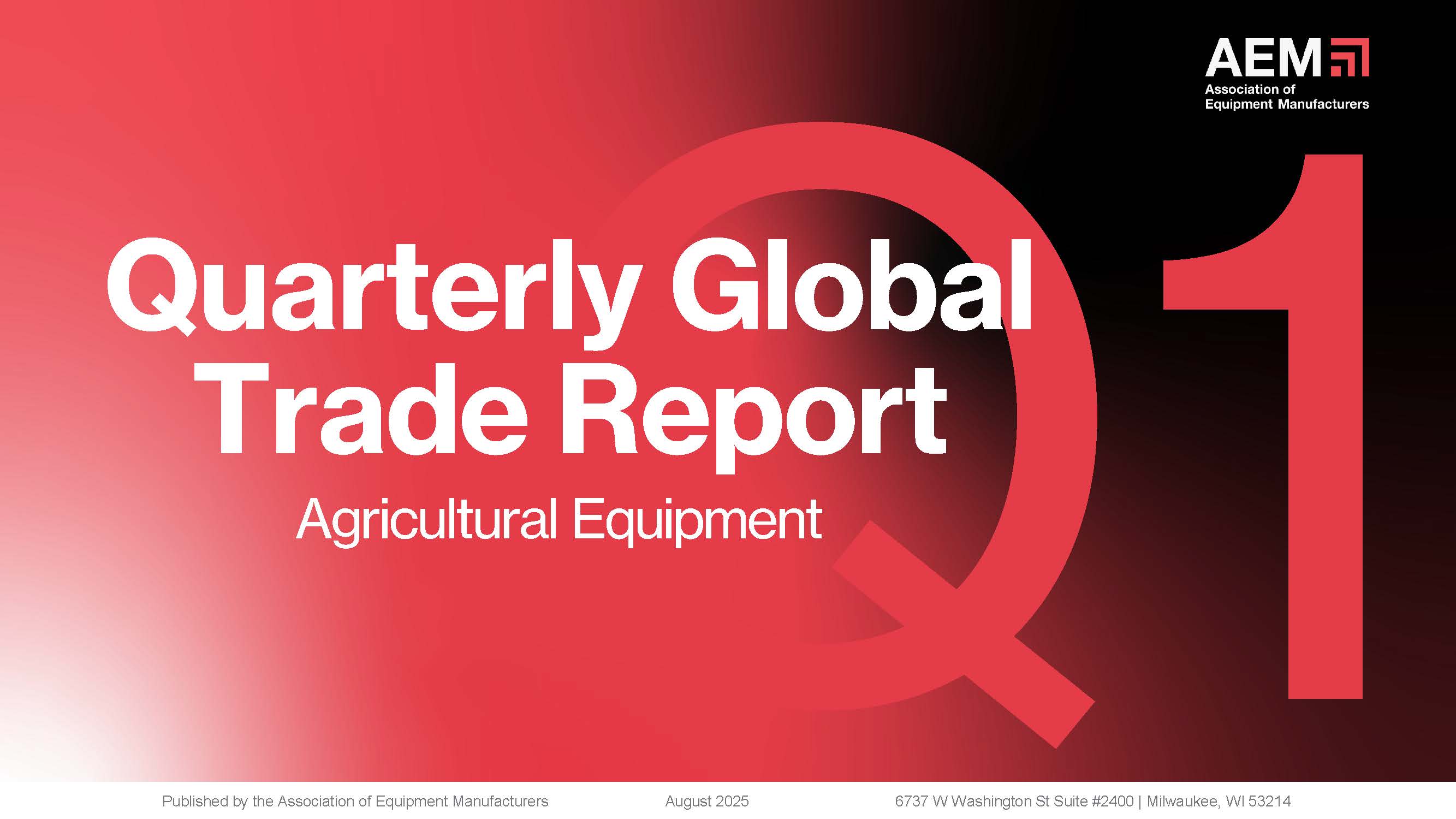A pair of leading construction industry professionals shared valuable insights and perspectives regarding sustainability in construction with hundreds of attendees at the recently held AEM Annual Conference in Napa, California.
David Bolderoff, fleet manager for the Los Angeles County Sanitation Districts, and Ken Burke, global equipment manager at Bechtel, joined moderator Dietmar Grimm, VP of corporate strategy and sustainability solutions at AEM member company Trimble, for a lengthy conversation regarding what’s on the horizon for the construction industry as it relates to regulatory compliance associated with sustainability, the challenges and opportunities associated with implementing sustainability solutions within their respective organizations and more.
Below are some excerpts from the discussion:
Grimm: What does sustainability mean to you, both individually and at your corporations? Why is it important to you?
Burke: We build projects that impact the globe on a long-term basis. So, we recognized very early that from a public opinion standpoint, things are starting to change as it relates to sustainability.
As good stewards, we need to make sure we take control and lean forward on our sustainability initiatives, as well as come up with something that is deployable, something we can go execute work, and something where we can, as an industry, control our destiny.
Bolderoff: I have a 1-year-old, and when I see her, I want to make sure that I leave the world in the best possible shape for her and her future kids.
But, from a business perspective, I work for a government agency in Los Angeles, and we’ve been carbon negative for a number of years now. It’s exciting to work for an agency like that. As the sanitation district, we manage wastewater and solid waste assets, serving 5.5 million people in Los Angeles. So, it’s important for us to be able to serve our constituents in their communities.
More specifically, what we do is recycle a lot of wastewater, we pull commodities out of the waste stream, we convert a lot of the biogas that we create on our landfills or wastewater treatment plants into renewable fuels, and we use that in the vehicles and equipment we operate, as well as provide that to the public.
AEM Annual Conference is the place for member executives to examine what is ahead for their organization and the equipment manufacturing industry. Attended annually by senior executives and the next generation of leadership in the off-road equipment manufacturing industry, this is the industry’s can’t-miss gathering. Learn more.
Grimm: We’re facing this continual flow of new regulations, even corporate initiatives you have withing your own organizations. What are the challenges you see on the horizon? California, for example, is one of these places where a lot of these regulations seem to come at the forefront before other states or countries are addressing them.
Bolderoff: Being in California with the California Air Resources Board, I recognize the state sets the tone for the country, and sometimes the world, regarding new emission-reduction technologies.
Two years ago, in September of 2020, California Gov. Gavin Newsom signed an executive order titled “Zero emissions by 2035.’ A lot of folks really zeroed in in one aspect of it. That was new vehicle sales by 2035 in California would all have to be zero-emission vehicles. It’s kind of aggressive, but I think when you read that executive order a little bit more, there’s so much more to it.
One is the requirement to transition all medium-duty and heavy-duty on-road vehicles to zero-emission by 2045. Not new sales, but rather convert entire fleets over by 2045. Particularly with the standard of technology today, that seems like a bit of a stretch.
What California and CARB are currently doing is developing an advanced clean fleets rule. And what they will require if the rule passes – in its present state – is agencies like mine would have to start buying 50% of our new medium-duty and heavy-duty trucks being zero-emissionsby 2024. Roughly 50% of our purchases would have to be zero-emission technology. It’s a very tall stretch for where the market is today in the medium-duty and heavy-duty space. There isn’t really a lot out there.
We just ordered five heavy-duty trucks. These would be the first we ordered a year ago, and they’ve taken a year to start rolling in for us. We’re going to convert these to various vocational applications, being dump trucks, roll-off trucks, or even truck tractors with wet kits. These are all going to have electric power take-offs (EPTOs) on them, they’re going to be used in various vocational applications in Los Angeles. We still call this a “pilot.” Part of this is still getting these trucks out there, getting them tested, and understanding what kind of battery drain is going to happen with these EPTOs in our types of applications, because there is a lot of work to do. To start ordering more and more of these within a year, it seems like we’re getting a little bit ahead of ourselves.
And just to tie that back to the off-road side with construction equipment, in that same executive order, Gov. Newsom stated that it was a goal of the state to implement or transition all heavy off-road equipment to zero-emission by 2035. Once again, this is not being able to sell zero-emission equipment by 2035, this was transitioning our entire fleet to zero emissions by 2035. That’s 12 years’ time. How many people think that’s doable? I certainly don’t.
I think there was one nuance in that goal, it was “whereas feasible,” so that is an escape, a nonbinding commitment. But seeing how CARB works, like the medium and heavy-duty truck rule that’s coming, I can see them bringing something out in the next couple of years that's going to start aggressively requiring us to transition to zero-emissions off-road equipment.
So, what I want to throw out there are manufacturers going to be ready to start providing fleets like ours with this kind of equipment in California or across the country as soon as the next couple of years? Because most of the equipment out there is at the pilot stage. There is quite a bit of small compact equipment, but once you start getting up into medium and larger classes of equipment, there isn't a lot that's readily available.
Grimm: How are you looking at that and these regulations moving forward?
Burke: Our biggest challenge right now is on a global basis. A lot of the countries where we execute work, it’s non-regulated, so you can’t even get ultra-low sulfur diesel. One thing we’re doing is looking at when we integrate our plan on decarbonization. We need to do it at the front end. If we’re going to have a hope on coming up with alternative ways to execute, we’re going to have to lean forward and put in that infrastructure.
It's a big hill to climb. So, from my perspective, we get what we get unless we lean forward advocate on what’s reasonable, what’s achievable, and we need to do the right thing to make sure that look after our environment.
Grimm: As we’re looking toward driving sustainability, when do you think there will be a fuller embrace of it over the coming decades?
Bolderoff: There is demand. To the manufacturers out there saying there’s no demand, there is. It’s just I think you just may not be hearing it from the right people. Like for our infrastructure projects, we’re doing that for the communities we serve. I think these communities, when awarding out our new infrastructure projects, there’s a huge environmental impact report (EIR) to process that goes through there. And I think if we can sell and storytell the amount of emissions we’re reducing, that shortens the timeline and approval process to these projects.
At a federal level, there’s a lot of funding coming out, and part of that funding for infrastructure projects is tied to that green or carbon greenhouse gas emissions. I think there's going to be more and more demand from large contractors that do these national and global projects, and it’s going to be driven by some of these federal requirements of funding, as well as doing the right thing for the communities that we serve.
Burke: So many of us are paralyzed because we don’t know which way to go. We’re all dabbling in different things. In reality, as we step off that ledge and truly embrace where we’re going, I think the development will accelerate.
You're going to see a lot more solutions come online in the next two or three years. Something that's a reasonable deployment is probably four or five years from now on certain things. Things we really want to focus on, from my perspective, is something that's deployable and something that I can maintain and go execute -- hybrids, efficiency, measuring, engineering solutions, such that we’re going to lower that carbon footprint. Looking at how we can do things better, these are the things we can do now.
In Europe, I had the opportunity to visit facilities and factories, and the demand pull there is completely different than what we’ve got here. It comes down to the education to reward that good behavior, giving the operator the incentive to shut the machine off. Let’s put cooling stations out there so they don’t have to run the engine. There are a lot of things we can do right now to make it better, but we’ve got some real challenges between now and then to get the technology to where it needs to be where it is reliable and deployable. However, ultimately, I believe in three to five years we’re going to see a significant change.
For more news and information regarding issues important to equipment manufacturers, subscribe to the AEM Industry Advisor.





